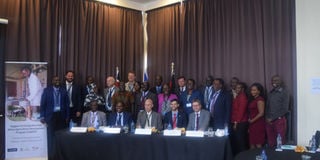Aquaculture curriculum launched to boost fish farming

Partners and stakeholders pose for a photo during the launch of the national aquaculture curriculum in Nairobi. The programme seeks to boost aquaculture in the country and enhance farmers' livelihoods while protecting L Victoria and its environment and natural resources. PHOTO | BRIAN OKINDA | NMG
What you need to know:
- The modular curriculum will be offered in various vocational training institutions, polytechnics and colleges throughout the country.
- According to Dr Mathias Braun, GIZ-Agriculture Programme’s programme director, it is the two-phased Trilateral Tilapia Cooperation, which has been running in the country since June 2012 to December 2016 that culminated in the development of the curriculum to carry on offering insights to fish farmers hence sustain their aquaculture doings.
- Through this programme, we intend to enhance sustainable ways of protecting L Victoria’s environment by creating alternative livelihoods for the communities living around the lake.
A national aquaculture curriculum has been launched to promote, boost and sustain farming of tilapia in fish ponds within the catchment areas of L Victoria, and outspreading countrywide.
The modular curriculum which will be offered in various vocational training institutions, polytechnics and colleges throughout the country, is part of joint efforts to sustain the declining fish population in L Victoria, enhance sustainable ways to protect the lake’s environment and eradicate poverty by creating alternate livelihoods other than lake fishing.
The curriculum which is part of the Trilateral Tilapia Cooperation, is a combined product Kenya’s Ministry of Agriculture, Livestock and Fisheries, the German Development Cooperation Agency, through Deutsche Gesellschaft für Internationale Zusammenarbeit GmbH (GIZ) and Israeli Foreign Affairs Ministry’s Agency for International Development Cooperation (MASHAV).
Speaking during the launch, the programme’s deputy manager, Ladislao Di Domenica said the curriculum, which is also backed by the Comprehensive African Agriculture Development Programme (CAADP) seeks to promote competency based hands-on training (CBET) to enable fish farmers fully benefit from it.
“This farmers-friendly flexible curriculum, currently running in institutions such as Ramogi Institute of Advanced Technology (RIAT), Jewlet Fish Farm, and Lake Basin Development Authority (LBDA) in Kisumu comprises 70 percent practical hands-on aspects of learning and 30 percent theoretical and with it, we expect to boost aquaculture and ensure the region’s and country’s tilapia productivity goes up,” said Di Domenica.
According to Dr Mathias Braun, GIZ-Agriculture Programme’s programme director, it is the two-phased Trilateral Tilapia Cooperation, which has been running in the country since June 2012 to December 2016 that culminated in the development of the curriculum to carry on offering insights to fish farmers hence sustain their aquaculture doings.
POTENTIAL TO DEVELOP
The first phase focused on 10 counties in the Western Kenya region, with the second phase focusing on up-scaled lessons learnt from phase one, and implemented in Kakamega, Bungoma and Siaya Counties.
“After providing all the requisite material and knowledge to the farmer, it was only noble that we give them an opportunity to further learn more and develop their fish farming even in our absence, hence this curriculum,” said Dr Braun.
He added that thus far, results have been promising with 50 percent increased profitability, a drop in ponds’ fish mortality rates, high reinvesting by fish farmers and private farms, increased yields and reduction in ponds’ maintenance and operation costs.
“Through this programme, we intend to enhance sustainable ways of protecting L Victoria’s environment by creating alternative livelihoods for the communities living around the lake,” said Sammy Macharia, the assistant director of Fisheries and Blue Economy.
He added that the curriculum will ensure that knowledge on aquaculture spreads across the country and further boosts the sub-sector which is showing great potential to develop in the coming decades.
As agriculture remains the core of the country’s economy, directly contributing 24 percent of the countries annual GDP, fisheries contribute 7.4 percent of this hence the need for harnessing the fisheries resources.





